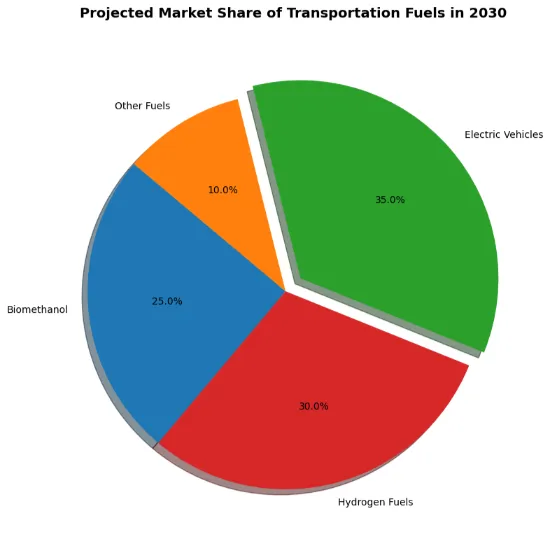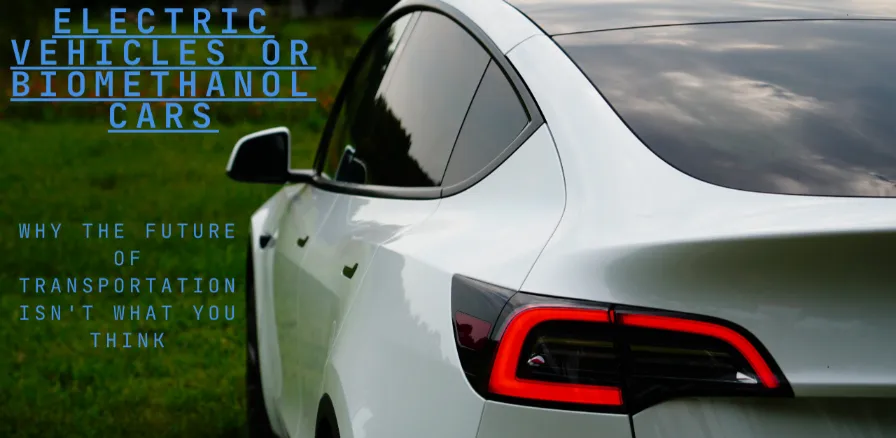
Electric Vehicles or Biomethanol Cars? Why the Future of Transportation Isn’t What You Think
The future of transportation is a hot topic. It’s often seen as a simple contest between electric vehicles (EVs) and traditional internal combustion engines. However, new technologies like biomethanol-powered cars and hydrogen fuels are changing this view. This blog explores why the future of transportation is more complex and promising than just a basic EV versus gasoline debate. We will look at the roles of biomethanol and hydrogen fuels, their environmental impacts, economic viability, and how they either compete with or complement electric vehicles in creating a sustainable transport system.
Understanding the Contenders: EVs, Biomethanol, and Hydrogen Fuels
Electric Vehicles: The Current Favorite
Electric vehicles have become popular because they produce no tailpipe emissions and have more charging stations. They run on batteries charged mainly with renewable electricity, offering a cleaner alternative to fossil-fuel-powered cars. Their advantages include:
- Reduced local air pollution
- Lower operational costs
- Increasing range and performance
However, EVs face issues like emissions from battery production, raw material extraction, and gaps in charging infrastructure.
Biomethanol Cars: The Renewable Liquid Fuel Alternative
Biomethanol is a type of methanol made from renewable sources like agricultural waste or municipal solid waste. It is a liquid fuel that can power modified internal combustion engines or fuel cells. Key benefits include:
- Compatibility with existing fuel infrastructure and engines with minor modifications
- High energy density compared to hydrogen, which simplifies storage and transport
- Potential for up to 90% greenhouse gas reductions compared to fossil fuels
Biomethanol provides a renewable, carbon-reducing option that uses current vehicle technology and fuel distribution networks. Learn more about biomethanol production processes.
Hydrogen Fuels: The Versatile Energy Carrier
Hydrogen fuels, particularly green hydrogen made from renewables through electrolysis, are attracting attention for their ability to decarbonize hard-to-electrify sectors. Hydrogen fuel cell vehicles emit only water vapor and offer:
- Fast refueling times
- Long driving ranges
- Zero tailpipe emissions
However, hydrogen also faces challenges, including storage issues, high production costs, and a lack of refueling infrastructure. Discover the latest developments in hydrogen infrastructure.
Lifecycle Environmental Impacts: How Do They Compare?
A key consideration for the future of transportation is the full lifecycle environmental impact, from raw material extraction to end-of-life disposal.
Electric Vehicles
Studies indicate that battery electric vehicles usually have lower lifecycle greenhouse gas emissions than conventional internal combustion vehicles. However, battery production requires a lot of energy and relies on mining important minerals like lithium and cobalt. The carbon intensity of the electricity used for charging also significantly impacts EV emissions.
Biomethanol Vehicles
Biomethanol cars can achieve significant greenhouse gas reductions—up to 90% compared to fossil fuels—due to the renewable materials used in production. The liquid nature of the fuel allows for easier integration with current infrastructure, decreasing emissions related to fuel distribution. Read about full lifecycle analysis of alternative fuels.
Hydrogen Fuel Cell Vehicles
Hydrogen fuel cell vehicles have nearly zero tailpipe emissions, but the environmental benefits depend heavily on how hydrogen is made. Green hydrogen produced from renewable electricity has the best emissions profile, whereas hydrogen derived from fossil fuels with carbon capture is less sustainable.
Economic and Infrastructure Considerations
Electric Vehicles
The adoption of EVs is rising quickly, supported by growing charging networks and lower battery prices. However, charging times and grid capacity remain issues, especially for long-distance travel and heavy-duty vehicles.
Biomethanol
Biomethanol can use current liquid fuel infrastructure, making it an attractive option for quick deployment. It also provides a solution for sectors where electrification is difficult, such as shipping and heavy transport. Nevertheless, large-scale sustainable biomass supply and effective conversion technologies still need development. Explore biofuel economics and policies.
Hydrogen Fuels
The hydrogen infrastructure is still new and expensive, requiring new pipelines, storage, and refueling stations. The production costs for green hydrogen are high but are expected to drop with advances in technology and scale.
Why the Future Isn’t Just EVs: The Case for a Multi-Fuel Future
Complementary Roles
- Urban and light passenger transport: EVs fit well here, as they handle short trips and have access to charging.
- Heavy-duty transport and shipping: Biomethanol and hydrogen fuels provide practical solutions where the weight of batteries and charging times limit EV effectiveness.
- Energy storage and grid balancing: Hydrogen and biomethanol can serve as energy carriers, storing excess renewable electricity and stabilizing the grid.
Sustainability and Resource Efficiency
A diverse range of transport fuels decreases reliance on any single resource or technology. This reduces risks related to raw material shortages, infrastructure issues, and regional differences in renewable energy availability.
Challenges Ahead for Biomethanol and Hydrogen Fuels
- Feedstock availability: Biomethanol production relies on sustainable biomass supply chains. These need careful management to prevent competition with food production and deforestation.
- Technology maturity: Effective conversion processes for biomethanol and cost-efficient green hydrogen production are still being developed.
- Policy and incentives: Strong regulations and financial incentives are essential to speed up adoption and infrastructure growth.
Conclusion: Rethinking the Future of Transportation
While electric vehicles are key to lowering transport emissions, they are not the only solution. Biomethanol and hydrogen fuels offer additional ways to reduce emissions in areas where EVs are limited. Biomethanol’s compatibility with current infrastructure and its potential for significant carbon reduction make it an appealing renewable fuel. Meanwhile, hydrogen fuels are important for heavy transport and industrial use due to their versatility and promise of zero emissions.
The future of transportation will combine various technologies—electric, biomethanol, hydrogen, and more—working together to create a sustainable, resilient, and low-carbon mobility system. For more insights, check out our future transportation scenarios report.

Authoritative Backlinks for Your Blog
- Springer – Electric Vehicles & Machine Learning: A review of how EVs are transforming transportation with AI and sustainability.
- FutureLearn – Are Electric Vehicles the Future of Transport?: A comprehensive breakdown of EV types, history, and environmental impact.
- BiofuelsPK – Will Biomethanol Cars Dominate?: A deep dive into biomethanol’s potential as a clean, scalable fuel.
- Market Research Intellect – Biomethanol Fuels in Eco-Transport: Trends and investment insights into biomethanol’s rise.
- Methanol Institute – Methanol: A Future-Proof Fuel: A primer on methanol’s role in future mobility and energy systems.
- Science News Today – EVs Driving Toward a Cleaner Future: How EVs contribute to grid stability and emissions reduction.
- World Biogas Association – Biomethane Cars & Net Zero: The role of biomethane and biomethanol in decarbonizing transport.

